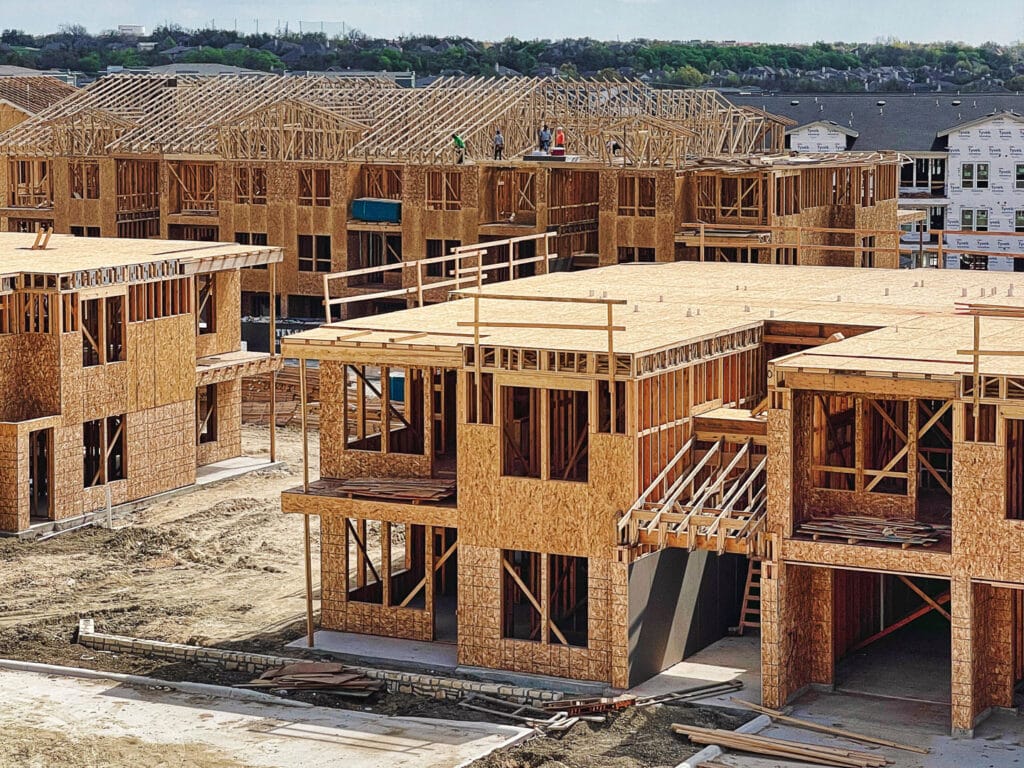
Job growth as an indicator
Traditional real estate investment analysis often emphasizes population and household growth as primary indicators to gauge the demand for multifamily units in a given market. However, Rick Scarola, a UF Bergstrom Real Estate Center advisory board member, introduces a compelling alternative metric that leverages employment data to gauge market health.
Scarola, a graduate of UF’s Warrington College of Business, runs Covenant Capital, a Nashville, Tenn.-based fund manager known for its strategic multifamily investments in the Southeast. He also sponsors an annual case study for Nathan S. Collier Master of Science in Real Estate students, which serves as a teaching opportunity to pass on what he has learned during his successful career investing in apartments.
An invaluable rule of thumb Scarola relies on posits that a healthy market can be identified when five new jobs are created for every new apartment unit. Focusing on employment rather than population metrics, this measure offers a granular and possibly more immediate gauge of a market’s vibrancy.
We hadn’t heard this heuristic before and so we decided to test its validity with current market data to see if the relationship holds.
Traditional residential market analysis
A growing population drives demand for residential properties. Market analysts typically examine population growth projections and average household size to determine the residential units needed to satisfy the increasing population. However, the challenge with examining population growth is the timing of the data.
The U.S. Census Bureau estimates the population and releases that information on a rolling schedule based on the type of data released. For example, the most recent population data available is from July 2023. The next release for national and state populations is December 2024 for the July 2024 data. Granular data, including county and metropolitan statistical area (MSA) data, will not be released until March 2025, with city data coming in May 2025. Therefore, a market analyst would typically use data almost a year old.
Analysts use private forecasted data from sources such as CoStar and ESRI to overcome this challenge. These forecasts come quickly but are still based on the data released by the U.S. Census Bureau. Given the delay in population data release, is there a timelier measure that can be an adequate replacement? The short answer is yes, employment.
Using employment as a proxy
A robust correlation exists between employment and population dynamics, with a 99% correlation coefficient that underpins the use of employment as a credible proxy for population estimations. In addition, the U.S. Bureau of Labor Statistics releases employment estimates monthly, down to the MSA level. This combination makes a compelling case for using employment to determine residential demand.
Translating employment to population requires a historical look at the ratio of new population to new jobs. Figure 1 shows this ratio for Florida from 2011 to 2023. During this period, Florida, on average, added 1.13 people for every new job, ranging from a high of 1.83 to a low of -0.53. By multiplying the average new-population-to-new-employment ratio with the total number of jobs created annually—291,979 jobs in 2023, for example—we extrapolate population increases and, subsequently, residential demand.
Figure 1 – New population to new jobs ratio for Florida
| Year | Employment | Population | New Employment | New Population | Ratio (NP/NE) | Avg. HH Size |
|---|---|---|---|---|---|---|
| 2010 | 6,990,579 | 18,204,924 | ||||
| 2011 | 7,107,891 | 18,419,340 | 117,312 | 214,416 | 1.83 | 2.62 |
| 2012 | 7,243,756 | 18,664,711 | 135,865 | 245,371 | 1.81 | 2.62 |
| 2013 | 7,444,500 | 18,917,482 | 200,744 | 252,771 | 1.26 | 2.65 |
| 2014 | 7,705,255 | 19,224,464 | 260,755 | 306,982 | 1.18 | 2.66 |
| 2015 | 7,990,290 | 19,579,283 | 285,035 | 354,819 | 1.24 | 2.66 |
| 2016 | 8,254,213 | 19,950,372 | 263,923 | 371,089 | 1.41 | 2.66 |
| 2017 | 8,436,971 | 20,257,937 | 182,758 | 307,565 | 1.68 | 2.67 |
| 2018 | 8,646,654 | 20,501,859 | 209,683 | 243,922 | 1.16 | 2.67 |
| 2019 | 8,844,697 | 20,716,086 | 198,043 | 214,227 | 1.08 | 2.66 |
| 2020 | 8,425,605 | 20,937,921 | -419,092 | 221,835 | -0.53 | 2.40 |
| 2021 | 8,958,005 | 21,213,901 | 532,400 | 275,980 | 0.52 | 2.49 |
| 2022 | 9,365,675 | 21,621,093 | 407,670 | 407,192 | 1.00 | 2.47 |
| 2023 | 9,657,654 | 21,947,429 | 291,979 | 326,336 | 1.12 | 2.47 |
| Average | 1.13 | 2.59 |
NP/NE=New population/new employment
Sources: CoStar, Bureau of Labor Statistics, UF Bergstrom Center
Diving deeper, the process extends to calculating the required number of new households by considering prevailing average household sizes, which, in 2023, warranted the creation of 127,834 new residential units to accommodate the derived population growth. The final analytical steps involve differentiating the demand between single-family and multifamily housing, guided by trends in homeownership rates. This extrapolated a demand for 43,051 multifamily units for Florida based on the renter rate of 33.7% in 2023.
Notably, the calculated demand for 2023 assumes no change in the occupancy of existing units. Therefore, new units satisfy all demand generated by new households.
Heuristics (the rule of thumb)

A thorough market analysis is indispensable to understanding consumer demand and strategically segmenting it into tailored products. Real estate professionals, however, often tackle the evaluation of numerous potential investments across a variety of markets. Implementing heuristics or “rules of thumb” can expedite and streamline the initial decision-making process. Scarola’s heuristic leverages employment growth as an indicative surrogate for population increases, providing a robust starting point for market selection.
To find out the efficacy of his rule of thumb, we conducted an analytical assessment focusing on the Florida real estate market from 2011 to 2023. Our analysis considered several critical metrics: the ratio of new population to new employment, average household size and the renter rate. These variables allowed us to compute the “new employment to renter demand ratio” (NE/RD), a pivotal indicator designed to synchronize new housing supply with burgeoning demand. The calculation details for NE/RD are outlined in the accompanying sidebar.
Over the past decade, our findings revealed that Florida’s average NE/RD ratio stood at 5.06, thereby corroborating the validity of Scarola’s heuristic approach (Figure 2). However, it is crucial to highlight that our demand calculation presumes static conditions—an assumption that does not account for variables such as the absorption of new demand by existing vacant units or loss of units due to aging infrastructure or natural disasters. Therefore, we used the NE/RD ratio as a benchmark to compare with the “new employment to delivered units ratio” (NE/DU).
Figure 2 – New employment to new apartment demand ratio
| Year | NP/NE Ratio | Avg. HH Size | Home Ownership Rate | NE/RD Ratio |
|---|---|---|---|---|
| 2011 | 1.83 | 2.62 | 69.0% | 4.62 |
| 2012 | 1.81 | 2.62 | 67.0% | 4.40 |
| 2013 | 1.26 | 2.65 | 66.1% | 6.21 |
| 2014 | 1.18 | 2.66 | 64.9% | 6.44 |
| 2015 | 1.24 | 2.66 | 64.8% | 6.07 |
| 2016 | 1.41 | 2.66 | 64.3% | 5.30 |
| 2017 | 1.68 | 2.67 | 64.1% | 4.42 |
| 2018 | 1.16 | 2.67 | 65.5% | 6.65 |
| 2019 | 1.08 | 2.66 | 66.0% | 7.23 |
| 2020 | -0.53 | 2.40 | 68.7% | -14.49 |
| 2021 | 0.52 | 2.49 | 67.2% | 14.64 |
| 2022 | 1.00 | 2.47 | 67.3% | 7.56 |
| 2023 | 1.12 | 2.47 | 67.3% | 6.76 |
| Average | 1.13 | 2.59 | 66.3% | 5.06 |
NP/RD=New population/new employment demand ratio
NE/RD=New employment to renter demand ratio
Sources: CoStar, Federal Reserve Economic Data, UF Bergstrom Center
It is important to note the difference between the two ratios. NE/RD evaluates the relationship between new employment and rental demand, regardless of the type of units that satisfy the demand. NE/DU is calculated using CoStar’s gross delivered units, which focuses on apartment deliveries.
Florida’s market performance (NE/DU) from 2011 through 2023 raises intriguing questions (Figure 3). During the initial years after the great financial crisis, the observed NE/DU ratio consistently exceeded its equilibrium threshold (NE/RD)—indicating a disproportionate increase in job creation relative to new apartment delivery. While the underlying causes remain subject to further investigation, it is plausible that the burgeoning single-family rental (SFR) industry absorbed a significant share of this new demand, indirectly alleviating pressure from apartment developers scrambling to secure funding for new projects.
RDNE/RD=New employment to delivered units ratio
NE/RD=New employment to renter demand ratio
Sources: CoStar, UF Bergstrom Center
By 2017, the NE/DU and NE/RD ratios had converged, suggesting a more balanced correlation moving forward. The average NE/DU from 2017 to 2023 was 5.52, while the average NE/RD was 4.68.
While state-level performance is interesting, real estate professionals are driven by local markets. Therefore, we evaluated the market performance for the major markets in Florida as defined by CoStar. These include Miami, Fort Lauderdale, Palm Beach, Jacksonville, Orlando and Tampa. Figure 4 shows that these markets followed a similar trend to Florida.
Sources: CoStar, UF Bergstrom Center
Based on our assessment, Scarola’s rule of thumb is a valid indicator of market health. However, like any rule of thumb, it should be backed up with more in-depth analysis to ensure that all factors affecting a market are understood. This is particularly important with the growing SFR and build-to-rent sectors that are not included in the CoStar data for delivered units.
Author: Tim Becker is executive director of the UF Bergstrom Real Estate Center.
Related Stories
Sign up for our mailing list
For the media
Looking for an expert or have an inquiry?
Submit your news
Contact us
Follow us on social
@ufwarrington | #BusinessGators


